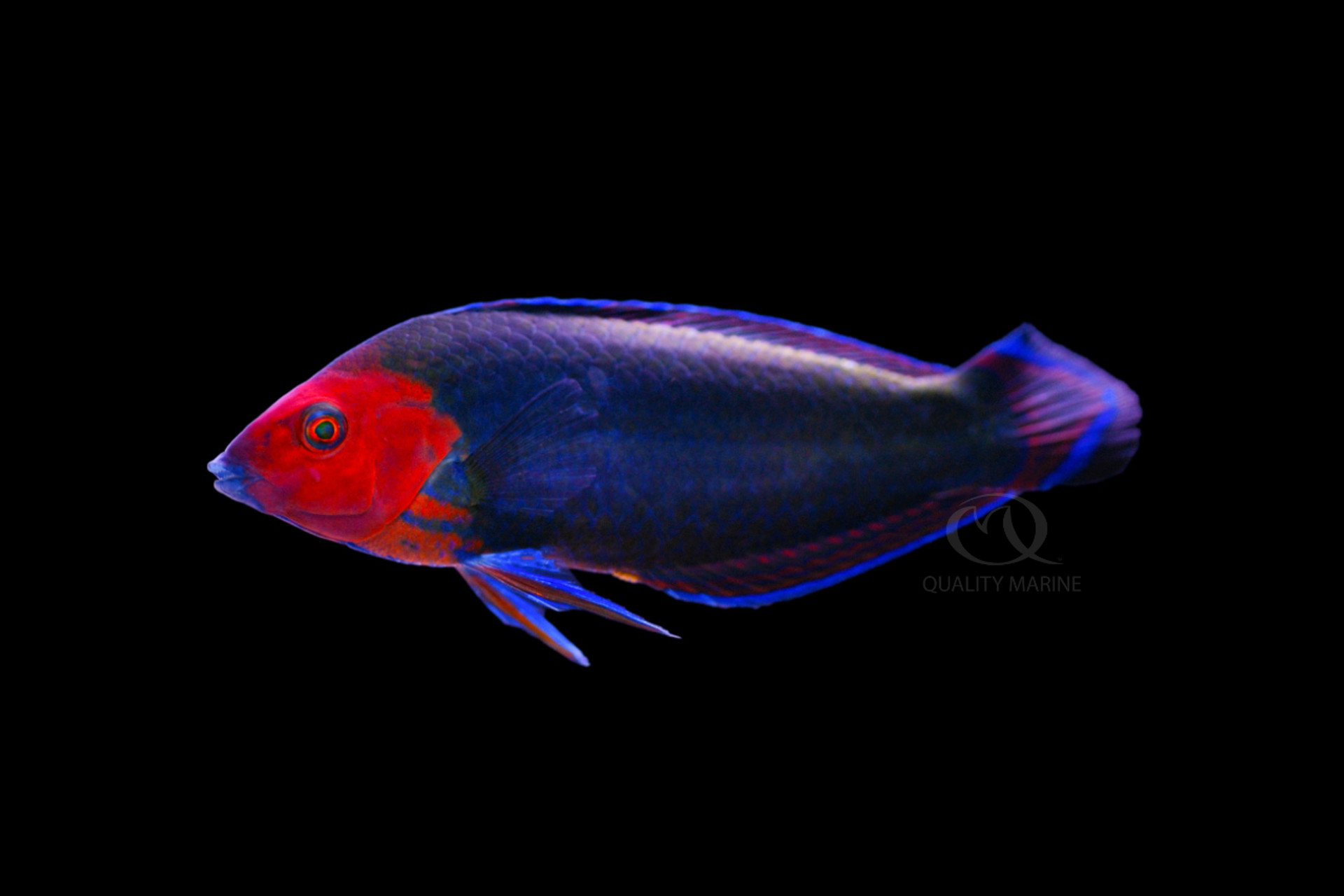Red Heads Are Hot

Halichoeres rubricephalus gets its scientific name from old Greek and translates roughly as red head salt pig. The red-head part is pretty obvious for anyone who has seen an adult male of the species, and the pig part is a reference to the upturned snout that is a feature of all the fish in the Genus Halichoeres. It is not a common fish to see in hobbyist aquariums, and so it isn't a huge surprise to find out that it only has a couple common names: Red Head Wrasse and Scarlet Head Wrasse. Over the years, we've seen a few retail stores and written sources add descriptors to these names, like Banggai Scarlet Headed Wrasse, or Red Head Reef Wrasse, but you get the idea.
This fish is found on stony coral reefs in the tropical western Pacific Ocean. They are all found in shallow water (usually less than 50 feet deep or so) and are found singly, in pairs and small harems (one male and a few females). Red Head Wrasses are one of the smaller wrasses in their genus, with the largest specimen on record being a hair under four inches long. The juveniles and females of this species are stunning, being very pale blue with bright orange stripes, they closely mimic a few other species in the genus like the Ornate Wrasse (H. ornatissamus), the Adorned Wrasse (H. cosmetus) among others. Females will transition into males if there is not a dominant male present, and there is no mistaking the male. The pale blue body of the female darkens into a deep blue-green while the stripes fade and the head turns a brilliant scarlet red. Interestingly, divers report that this red head can even be seen near the deeper end of the Red Head Wrasses depth range. Red as a wavelength doesn't penetrate water well, so anything that looks red can usually only seen very near the surface (without supplemental light).
Halichoeres rubricephalus live primarily on small invertebrates, copepods, small worms, snails, shrimp etc. As such, they are really easy to feed in captivity. They take very well to thawed mysis and other chopped seafood. In house, we feed them a mix of thawed foods from Gamma, and a small nutrient dense pellet from Nutramar called Nutramar Marine Complete. We do this twice a day, and suggest you keep that going. These fish are very active and like to graze. They don't necessarily need two feeds a day, but we find they do better this way. Because they like to eat invertebrates, they are likely to eat very small ornamental shrimp like anything in the Perclimines genus. Conversely, we've never heard of them taking out the larger cleaner shrimp. Also on the plus side, is that they are also likely to eat common aquarium pests like Asterina Stars, Flatworms, Mites and even some of the small snails that can reproduce in plague proportions.
Red Head Wrasses should be kept in a tank that is at least 40 gallons for a single individual, and larger would be better. For those of you attempting to keep them as a harem, we suggest 55-gallon aquariums as a starting point. They will appreciate décor that is rich with caves and swim throughs for them to hunt in. Red head wrasses do very well in brightly lit, reef style aquariums with lots of flow; additionally, this is where their colors and activity really pop as well. Like any wrasse, Red Heads can bolt quickly, which may have them end up on the floor, so we recommend covering your display.
Like all Halichoeres wrasses, Red Head Wrasses will also do best when kept in aquariums that have at least an inch of sand in it; here they will hide and sleep. While sand isn't an absolute requisite, you'll find your fish will be less skittish and healthier if given some. Sand shouldn't be course, as “gravel” grade substrates will irritate their skin and be difficult to dive into. Some attribute the excellent disease resistance of these fish to their sand dwelling habits, though we haven't seen any actual data to support this claim.
Red Head Wrasses are easy to pick tankmates for. They will be fine with almost any fish you keep them with. They can stick up for themselves with more aggressive fish, but don't seem to have much for aggressive tendencies themselves. You should avoid very timid, slow swimming fish as they will get out competed for food. Also, if you have a notoriously mean, fully grown Domino Damsel, you probably shouldn't be putting any more fish in there with it.
Halichoeres rubricephalus are “reef safe” meaning they are very unlikely to bother your corals of any type. In some ways they could be considered even better. Maybe we should make a title called “reef beneficial” because of their previously referenced aptitude for hunting down pests. With all this in mind, you should also be cautioned about keeping any Halichoeres with Tridacna clams. Many aquarists report this not to be an issue, but we've seen instances where fish in this genus have picked on clam's mantle to the deterioration of the clams. They might also be interested in taking bites out of large starfish, and so we don't recommend keeping them with fragile ones like Purple Linckia.
Halichoeres rubricephalus is a nearly perfect aquarium fish, as long as you aren't into keeping tiny ornamental shrimp or stars. They are resistant to most common aquarium maladies and do well in a wide variety of water quality parameters. They are incredibly active, fun to watch and drop dead gorgeous. Their rarity in the hobby means you might be the only fish geek you know with one of these “reef beneficial” beauties! Head to your Local Fish Store, ask for a harem of Red Head Wrasse from Quality Marine today!